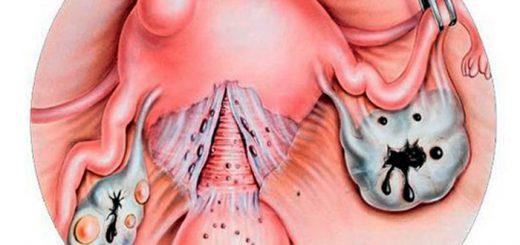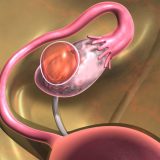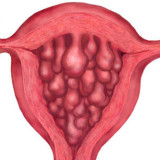Cystoma of the left ovary is a fairly common disease among women of all ages. What are their causes, symptoms and how should ovarian cysts be treated? Don’t think that there is only one way of treatment. There are different types of ovarian cystoma, each of them requires its own approach to treatment.
Cystoma of the left ovary is a pathological cavity filled with fluid or compaction of tissues inside the walls of the ovary. The ovarian cyst can be in a single copy or exist in the form of several formations at once. Formations can simultaneously be located outside the ovary, inside or on its walls. The size of the cystoma of the left ovary can also be different. It may be as little as a nut or as big as an orange. There are also different types of cysts. They are distinguished by structure, cause of occurrence. Some ovarian cysts can be soft, while others have a very hard shell.
Causes of cystoma of the left ovary
There is no single specific reason for the formation of cyst. Moreover, each of it’s species is due to different factors.
Types of cysts:
- Follicular cysts. Classified as functional, which arise from Graaff’s unexploded or hypertrophied follicle;
- Functional cysts are formed from the corpus luteum, which does not disappear, despite the absence of pregnancy. Due to hormonal disorders, many corpus luteum can form. This suggests the occurrence of polycystosis, which is the cause of polycystic syndrome;
- Endometroid cysts (chocolate cysts). They are the result of endometriosis – a disease in which parts of the endometrium are separated, pieces of the mucous membrane can penetrate into the ovaries and initiate the formation of cysts. These cysts have a dark brown color (this is the reason for the name “chocolate cyst”), because they are filled with dark blood. This type of cyst is quite dangerous. When such a cyst ruptures, blood can enter the abdominal cavity and cause inflammation of the peritoneum;
- Dermatoid cysts (leathery cysts). They arise from the elements of an undeveloped fetus (cells, bone tissue). Until now, doctors do not know what causes the formation of this type of cysts.
Symptoms of cystoma of the left ovary
Small cysts can rarely be noticed immediately due to the insignificant number of symptoms or their complete absence. Often their detection is random. For example, as a result of a control ultrasound scan. Large cysts usually produce clear symptoms, including:
- ovarian pain
- abdominal pain
- flatulence
- constipation
- often urination
One of the warning signals that may indicate the occurrence of ovarian cysts are menstrual disorders, spotting, postmenstrual bleeding, headaches, nausea, vomiting.
How is a cystoma of the left ovary treated?
The method of treatment of cystoma of the left ovary and decisions about the treatment should be made after a thorough diagnosis by a specialist. Cystoma of the left ovary does not always require serious treatment. The main way to diagnose cystic lesions in the ovary is by ultrasound of the vagina. With it, you can determine the size, shape and structure of the tumor. In case of detection of cystic formation of the patient is sent to the doctor for a cyst biopsy.
Small cystomas of the left ovary are usually not dangerous and do not require treatment. The only indication for a patient is only regular annual ovarian monitoring.
How cysts of different types are treated:
- Large functional cysts are usually treated with hormonal treatment (usually with contraceptives), which restores the hormonal balance in the woman’s body and leads to the removal of the cyst;
- Treatment of chocolate cysts includes surgical removal of tumors. Treatment is applied immediately. Mainly due to the risk of a cyst rupture and its contents entering the abdominal cavity. This phenomenon is very dangerous for health due to possible fatal outcome;
- If a woman has dermatoid cysts, surgical removal is usually recommended. Even if they have a slight change in their structure. The doctor decides whether the cyst will be excised by the laparoscopic method or the standard method;
- In the case of cysts that are malignant (cancer), cancer treatment must be carried out immediately.
The danger of cystoma of the left ovary
If the cystoma of the left ovary is large and continues to grow or there are already a few formations, the doctor may recommend removing the entire ovary. But it isn’t so scary. The woman still maintains her reproductive function because the second ovary is still healthy.
Carefully monitor your health. Regularly visit the gynecologist. If a doctor finds a cyst and prescribed a treatment, then always follow his instructions.














